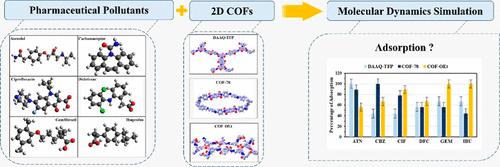当前位置:
X-MOL 学术
›
Ind. Eng. Chem. Res.
›
论文详情
Our official English website, www.x-mol.net, welcomes your feedback! (Note: you will need to create a separate account there.)
Removal of Pharmaceutical Pollutants from Wastewater Using 2D Covalent Organic Frameworks (COFs): An In Silico Engineering Study
Industrial & Engineering Chemistry Research ( IF 4.2 ) Pub Date : 2022-06-17 , DOI: 10.1021/acs.iecr.2c00924 Mehdi Ghasemi 1 , Mohammad Khedri 2 , Mohsen Didandeh 3 , Mojtaba Taheri 4 , Ebrahim Ghasemy 5 , Reza Maleki 6 , Ho kyong Shon 7 , Amir Razmjou 8, 9
Industrial & Engineering Chemistry Research ( IF 4.2 ) Pub Date : 2022-06-17 , DOI: 10.1021/acs.iecr.2c00924 Mehdi Ghasemi 1 , Mohammad Khedri 2 , Mohsen Didandeh 3 , Mojtaba Taheri 4 , Ebrahim Ghasemy 5 , Reza Maleki 6 , Ho kyong Shon 7 , Amir Razmjou 8, 9
Affiliation

|
The increasing amounts of emerging contaminants (ECs) in aquatic ecosystems are becoming one of the serious environmental issues. Therefore, the efficient removal of ECs is of urgent importance. Herein, a computational technique of molecular dynamics (MD) and the density functional theory (DFT) were employed to assess the adsorption affinity of three regenerable covalent organic frameworks (COFs), namely, DAAQ-TFP, COF-78, and COF-OEt, for the removal of six different ECs from the different pharmaceutical groups, including atenolol, carbamazepine, ciprofloxacin, diclofenac, ibuprofen, and gemfibrozil. Detailed analyses showed that DAAQ-TFP and COF-78 were more efficient in removing atenolol (100%) and carbamazepine (100%) with Gibbs free energy values of −24.48 and −21.15 kJ/mol, respectively. COF-OEt possessed the highest absolute value of the Gibbs free energy, interaction energy, and adsorption affinity in removing ciprofloxacin (88%), diclofenac (63%), ibuprofen (100%), and gemfibrozil (100%). The hydrogen bond formation and van der Waals forces were introduced as the primary adsorption mechanisms. In addition, it was shown that COFs with a pore-based structure have lower capability for the removal of pollutants. The primary aim of this research work is to introduce efficient and regenerable COFs as a promising adsorbent for the removal of pharmaceutical pollutants.
中文翻译:

使用二维共价有机框架 (COF) 从废水中去除药物污染物:计算机工程研究
水生生态系统中越来越多的新兴污染物 (EC) 正在成为严重的环境问题之一。因此,有效去除 ECs 显得尤为重要。在此,采用分子动力学 (MD) 和密度泛函理论 (DFT) 的计算技术来评估三种可再生共价有机框架 (COF) 的吸附亲和力,即 DAAQ-TFP、COF-78 和 COF-OEt ,用于从不同的药物组中去除六种不同的 EC,包括阿替洛尔、卡马西平、环丙沙星、双氯芬酸、布洛芬和吉非罗齐。详细分析表明,DAAQ-TFP 和 COF-78 更有效地去除阿替洛尔 (100%) 和卡马西平 (100%),吉布斯自由能值分别为 -24.48 和 -21.15 kJ/mol。COF-OEt在去除环丙沙星(88%)、双氯芬酸(63%)、布洛芬(100%)和吉非罗齐(100%)时具有最高的吉布斯自由能、相互作用能和吸附亲和力绝对值。引入氢键形成和范德华力作为主要吸附机制。此外,研究表明具有孔基结构的COFs去除污染物的能力较低。这项研究工作的主要目的是引入高效和可再生的 COF 作为一种有前途的吸附剂,用于去除药物污染物。结果表明,具有孔结构的COFs去除污染物的能力较低。这项研究工作的主要目的是引入高效和可再生的 COF 作为一种有前途的吸附剂,用于去除药物污染物。结果表明,具有孔结构的COFs去除污染物的能力较低。这项研究工作的主要目的是引入高效和可再生的 COF 作为一种有前途的吸附剂,用于去除药物污染物。
更新日期:2022-06-17
中文翻译:

使用二维共价有机框架 (COF) 从废水中去除药物污染物:计算机工程研究
水生生态系统中越来越多的新兴污染物 (EC) 正在成为严重的环境问题之一。因此,有效去除 ECs 显得尤为重要。在此,采用分子动力学 (MD) 和密度泛函理论 (DFT) 的计算技术来评估三种可再生共价有机框架 (COF) 的吸附亲和力,即 DAAQ-TFP、COF-78 和 COF-OEt ,用于从不同的药物组中去除六种不同的 EC,包括阿替洛尔、卡马西平、环丙沙星、双氯芬酸、布洛芬和吉非罗齐。详细分析表明,DAAQ-TFP 和 COF-78 更有效地去除阿替洛尔 (100%) 和卡马西平 (100%),吉布斯自由能值分别为 -24.48 和 -21.15 kJ/mol。COF-OEt在去除环丙沙星(88%)、双氯芬酸(63%)、布洛芬(100%)和吉非罗齐(100%)时具有最高的吉布斯自由能、相互作用能和吸附亲和力绝对值。引入氢键形成和范德华力作为主要吸附机制。此外,研究表明具有孔基结构的COFs去除污染物的能力较低。这项研究工作的主要目的是引入高效和可再生的 COF 作为一种有前途的吸附剂,用于去除药物污染物。结果表明,具有孔结构的COFs去除污染物的能力较低。这项研究工作的主要目的是引入高效和可再生的 COF 作为一种有前途的吸附剂,用于去除药物污染物。结果表明,具有孔结构的COFs去除污染物的能力较低。这项研究工作的主要目的是引入高效和可再生的 COF 作为一种有前途的吸附剂,用于去除药物污染物。


























 京公网安备 11010802027423号
京公网安备 11010802027423号